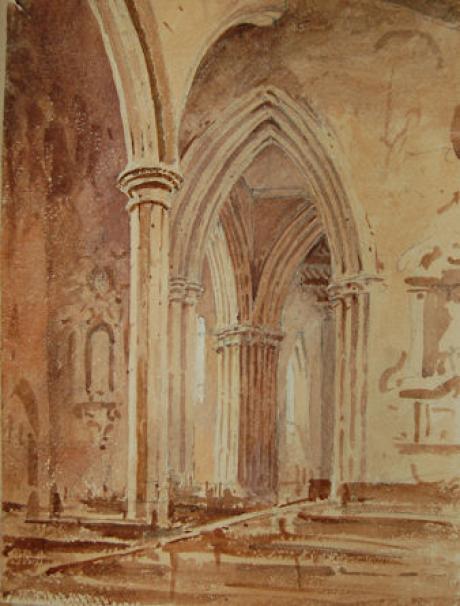inscribed as title on the reverse
Caythorpe is a large village in South Kesteven, Lincolnshire north of Grantham on the A607. North of the village is Fulbeck, and south are Normanton and Carlton Scroop. Caythorpe Heath stretches east of the village right across to Ermine Street, and Byards Leap. The nearby Caythorpe Court (to the east of the village) since 1946 was for many years Kesteven Agricultural College (the only south-west Lincolnshire agricultural college, noting how agricultural Lincolnshire is). In 1980, it became part of Lincolnshire College of Agriculture and Horticulture. It was taken over by De Montfort University in 1994, in the hope it would attract wider country interest. When Riseholme Agricultural College (also part of De Montfort, with which it was linked) was adopted by the new University of Lincoln in October 2001, Caythorpe was subsumed into the new university, though the distance from Lincoln would prove too much to manage for the university's management. Under the regime of the new Lincolnshire School of Agriculture, no longer a satellite college to Leicester, it sadly shut in September 2002. The old college was then turned into one of many PGL's activity centres. Caythorpe Hall is on the northern edge of the village; it was built between 1824 and 1827 for Colonel Packe, in the classical style. The park wall is all that remains of the earlier house, the seat of the Hussey family. The village church is St Vincent, a 14th Century listed building. The village pubs are the Red Lion and the Waggon & Horses. There was once a Caythorpe railway station on the line between Grantham and Lincoln. Mensa International has had its registered office in the village since 2008.
John Louis Petit was born at Ashton-under-Lyne, Lancashire, son of John Hayes Petit. He was educated at Eton, and contributed to the "Etonian". He was elected to a scholarship at Trinity College Cambridge in 1822, graduated BA in 1823 and MA in 1826, and on 21st June 1850 he was admitted "ad eundem" at Oxford. He took holy orders in 1824, but undertook no parochial work. Petit showed a taste for sketching in early years. His favourite subject was old churches, and a great part of his life was spent in visiting and sketching them. In 1839 he made his first extensive tour of the continent. The results appeared in his "Remarks on Church Architectire" (1841, 2 vols which had illustratuions. It was followed in 1846 by "Remarks on Church Architectural Character" Royal folio format.In the same year Petit published a lecture which he had delivered on 24th Feb 1846 to the Oxford Society for promoting the study of Gothic Architecture, under the title "Remarks on the Principles of Gothic Architecture as applied to ordinary Parish Churches". It was succeeded by "Architectire of Tewksbury Abbey Church". Royal svo 1846. " Architectural notes in the neighbourhood of Cheltenham"and "Remarks on Wimborne Minster", 1847. "Remarks on Southwell Minster". With numerous good illustrations. 1848. "Architectural Notices relating to Churches in Gloucestershire and Susse". 1849. "Architectural Notices of the Curious Church of Gillingham.Norfolk". And an "Account of Sherborne Minster". 1850. In 1852 Petit published an account of Brinkburn Priory". In 1854 appeared Petit's principal work. "Architectural Studies in France", imperial SVO. It was beautifully illustrated with fine woodcuts and facsimiles of anastic drawings by the author and his companion, Professor Delamotte. It showed much learningand observation, and threw light upon the formation of Gothic in France, and on the differences between English and French Gothic. A new edition , revised by Edward Bell, FSA, with introduction, notes and index, appeared in 1890. The text remained unaltered but the illustrations were reduced in size, and a few added from Petit's unused woodcuts. In 1864-65 he travelled in the East and executed some striking drawings. He died in Lichfield on 2 Dec 1868, from a cold caught while sketching and was buried in St Micheal's Churchyard. Petit was the founder of the British Archealogical Institute at Cambridge in 1844. He was also FSA, an honoury member of the Institute of British Architects, and a governor of Christ's hospital.

